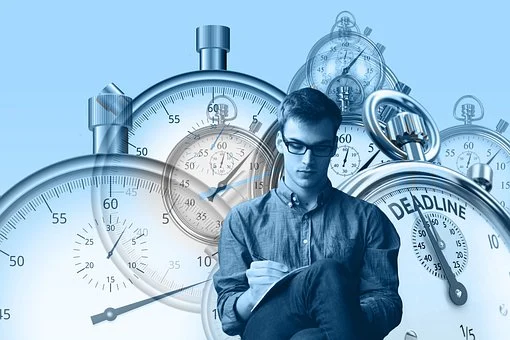Optimal work

Briefly
Optimal work is a work and study technique to help you focus on your work and get the most of it while keeping it meaningful and even fun.
We explain the details in the next section, but briefly the idea is to divide the work time into blocks of 45-60 minutes. Each block is one golden hour.
- Begin it with a short brake of 5-10 minutes to decide what do you want to do and how to do it in 3-4 clear steps.
- 30-45 five of intense work avoiding multitasking and distractions.
- 5 minutes to analyze how the golden hour worked and how it has helped you.
Here is a textbox for you to set your own study goals for the next golden hour. Set one main goal and divide it in 3-4 tasks.
You can use the chronometer to keep track of time and set your personal deadline.
One important aim of this approach is to set clear deadlines in the working time. If you set it to 45 minutes, make it really 45. Not 40 nor 50. By doing so, your brain segregates adrenaline to help you meet your objectives on time and also gets used to considering deadlines as a serious line. Avoid being flexible there and it will help you work faster and better in the future.
In the next sections will explain the concepts more deeply and tell about reframing, mindfulness and challenging yourself. These are useful tools for you, so keep reading.
Optimal work
If you are not familiar with optimal work, here are the basics. Optimal work uses a tool called the golden hour. The golden hour is an hour of work, when you achieve the most. To have a golden hour, you need to achieve the state of mind called flow, which is the state when you are the most productive, intelligente and concentrated. Flow is such a state where you focus so much as to lose the sense of time, not feeling hunger or thirst, and feeling enthusiasm towards your objective.
We can achieve this state and maximum effectiveness of work with 3 steps. The first one is reframing, the second mindfulness and the third is challenge.
Reframing changes the attitude

Reframing means changing the point of view of the objective or task from being a threat to an opportunity. This does two things. It removes the negative emotions involving the object or task and it motivates you to face it as a chance of achieving something good (because it’s an opportunity for something beneficial).
Mindfulness keeps our thoughts on the task

Mindfulness enables us to concentrate on the present moment and it trains our minds to keep all attention on the task or objective. Mindfulness is deliberately putting all of your attention into the present moment. As an attention training exercise, the goal of mindfulness is to achieve silence of thought, prevent your thoughts from wandering off. It is just that simple. You can find many techniques on mindfulness, the most basic and best exercise is just focusing on breathing. Mindfulness also has physical signs such as lowered heart rate and general calmness.
Breathing exercise: Sit in a comfortable, upright position and close your eyes. Start by taking a deep breath and feel how the air fills your lungs and raises your chest. Focus on long inhales and exhales. You can count at the same time as you breathe in and you can hold it for a few seconds and you do the same with exhaling. If your thoughts wander off, just bring them back to the breathing. Doing this fifteen minutes a day has positive benefits both in raising awareness and lowering anxiety.
Challenge brings enthusiasm

Challenge is the emotional boost to kickstart the flow state. One of the signs of flow is enthusiasm, but it does not have to come from the flow state. By setting a challenge of the appropriate magnitude, while working you can see yourself achieving it and you gain confidence and enthusiasm. Now you can see why challenging yourself is so important. Keep in mind that setting the bar too high or too low will not benefit you in gaining enthusiasm but irritates, discourages or bores you. You need the right kind of challenge that you can achieve and you become enthusiastic while doing it. Challenges can be in two fields of your work/goal: quantity and quality. You can do more or you can do better (even both). You should start from something achievable but not easily achievable. The key word here is appropriate, you don’t want something too hard. Setting a goal of achieving 5, 10 or 15% more in the same time or achieving greater quality is a good beginning.
Now that we have talked about the flow state, let’s come back to the golden hour. You achieve the optimal working state by achieving flow. This means reframing the task from something that should be avoided or getting over it as fast as possible to something that you look forward to do. Now you have to be mindful and give all of your attention to the task. The final step is getting enthusiastic by setting a challenge. Enthusiasm sparks the flow state and it is also the thing that keeps it going. Great, you can now really build the environment that you are going to work in.
First, get away from other people, find a quiet place and minimize all distractions for the next hour. Clear your workspace, turn off your phone (or mute it) and close all your non-work related browser windows on the computer. Weather the resources that you will need for your task. It is also good to do breathing exercises, for warmup. Set your challenge and the work begins.